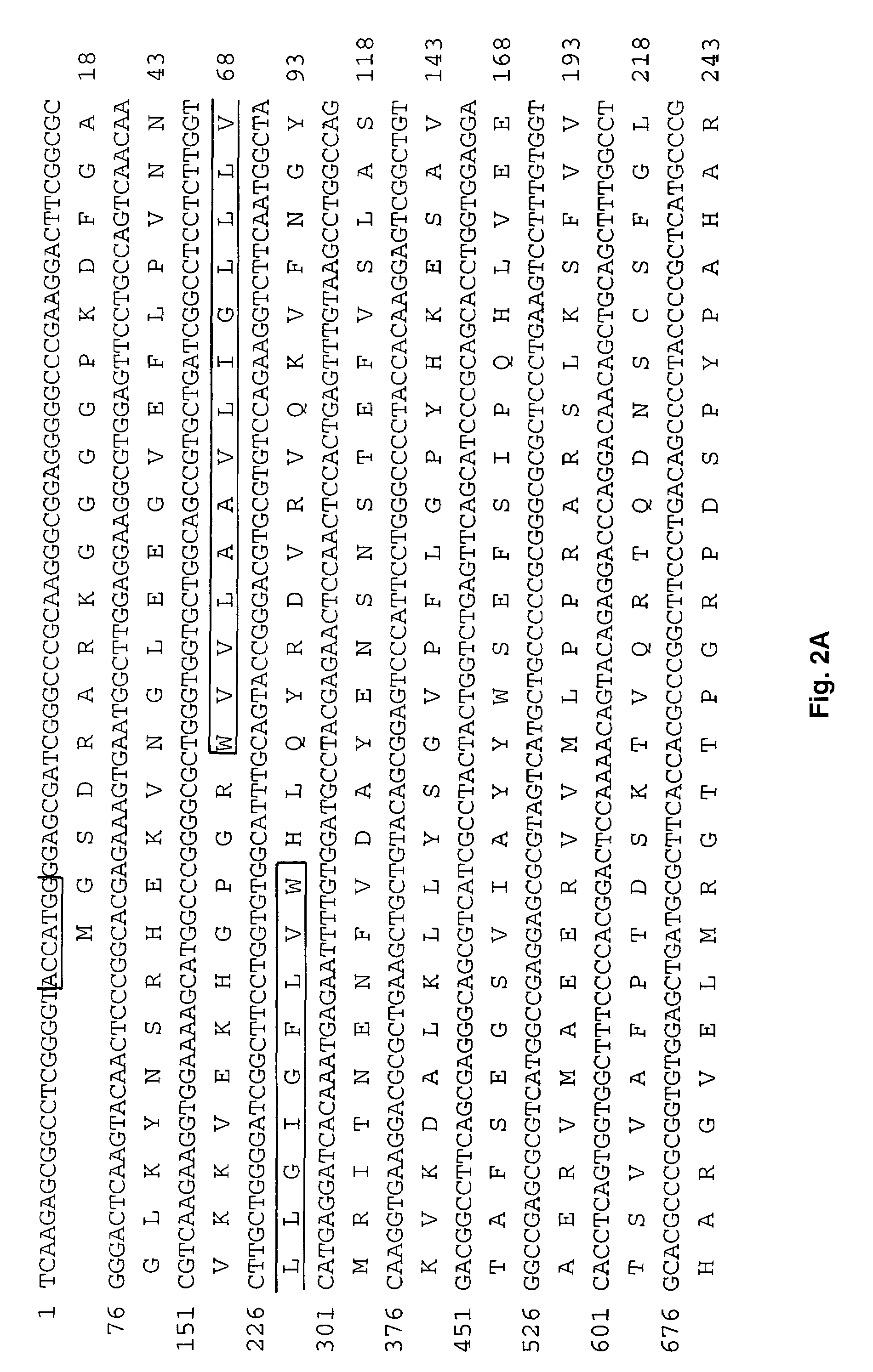TADG-15: an extracellular serine protease overexpressed in carcinomas
a serine protease and extracellular technology, applied in the field of cellular biology and the diagnosis of neoplastic disease, can solve the problems of deficiency in screening methods prior to the present day
- Summary
- Abstract
- Description
- Claims
- Application Information
AI Technical Summary
Benefits of technology
Problems solved by technology
Method used
Image
Examples
example 1
Tissue Collection and Storage
[0099]Upon patient hysterectomy, bilateral salpingo-oophorectomy, or surgical removal of neoplastic tissue, the specimen is retrieved and placed on ice. The specimen was then taken to the resident pathologist for isolation and identification of specific tissue samples. Finally, the sample was frozen in liquid nitrogen, logged into the laboratory record and stored at -80° C.
[0100]Additional specimens were frequently obtained from the Cooperative Human Tissue Network (CHTN). These samples were prepared by the CHTN and shipped on dry ice. Upon arrival, these specimens (e.g., blood (serum), urine, saliva, tears and insterstitial fluid) were logged into the laboratory record and stored at -80° C. Participation of the following divisions of the Cooperative Human Tissue Network (CHTN) in providing tumor tissues is acknowledged: Western Division, Case Western Reserve University, (Cleveland, Ohio); Midwestern Division, Ohio state University, (Columbus, Ohio); Eas...
example 3
PCR with Redundant Primers, Cloning of TADG-15 cDNA, T-vector Ligation and Transformations and DNA Sequencing
[0104]Redundant primers,[0105]forward 5′-TGGGTIGTIACIGCIGCICA(C / T)TG-3′ (SEQ ID No. 11) and reverse 5′-A(A / G)IGGICCICCI(C / G)(T / A)(A / G)TCICC-3′ (SEQ ID No. 12), corresponding to the amino acids surrounding the catalytic triad for serine proteases, were used to compare the PCR products from normal and carcinoma cDNAs.
[0106]The purified PCR products were ligated into the Promega T-vector plasmid and the ligation products used to transform JM109 competent cells according to the manufacturer's instructions (Promega). Positive colonies were cultured for amplification, the III / grade III ovarian adenocarcinoma patient. Three overlapping clones were obtained which spanned 3147 nucleotides.
example 4
Northern Blot Analysis
[0107]10 μg mRNAs were size separated by electrophoresis through a 1% formaldehyde-agarose gel in 0.02 M MOPS, 0.05 M sodium acetate (pH 7.0), and 0.001 M EDTA. The mRNAs were then blotted to Hybond-N+ nylon membrane (Amersham) by capillary action in 20×SSPE. The RNAs are fixed to the membrane by baking for 2 hours at 80° C. 32P-labeled cDNA probes were made by Prime-a-Gene Labeling System (Promega). The PCR products amplified by the same primers described above were used for probes. The blots were prehybridized for 30 min and hybridized for 60 min at 68° C. with 32P-labeled cDNA probe in ExpressHyb Hybridization Solution (CLONTECH). Control hybridization to determine relative gel loading was performed with a β-tubulin probe.
[0108]Normal human tissues; spleen, thymus, prostate, testis, ovary, small intestine, colon and peripheral blood leukocyte, and normal human fetal tissues; brain, lung, liver and kidney (Human Multiple Tissue Northern Blot; CLONTECH) were a...
PUM
| Property | Measurement | Unit |
|---|---|---|
| temperature | aaaaa | aaaaa |
| pH | aaaaa | aaaaa |
| pH | aaaaa | aaaaa |
Abstract
Description
Claims
Application Information
 Login to View More
Login to View More - R&D
- Intellectual Property
- Life Sciences
- Materials
- Tech Scout
- Unparalleled Data Quality
- Higher Quality Content
- 60% Fewer Hallucinations
Browse by: Latest US Patents, China's latest patents, Technical Efficacy Thesaurus, Application Domain, Technology Topic, Popular Technical Reports.
© 2025 PatSnap. All rights reserved.Legal|Privacy policy|Modern Slavery Act Transparency Statement|Sitemap|About US| Contact US: help@patsnap.com



